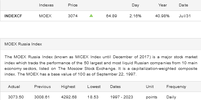bigdog
Retired many years ago
- Joined
- 19 July 2006
- Posts
- 8,269
- Reactions
- 5,736
Russia Stock Market Index MOEX CFD - Quote - Chart - Historical Data - News
The main stock market index in Russia (MOEX) increased 181 points or 5.84% since the beginning of 2024, according to trading on a contract for difference (CFD) that tracks this benchmark index from Russia. Russia Stock Market Index MOEX CFD - values, historical data, forecasts and news - updated...
The ruble-based MOEX Russia index extended early gains and closed 1.3% higher at 2,975 on Tuesday, progressing for a third session to levels last seen since the Russian invasion of Ukraine triggered a stock market crash in February 2022.
Gains were broad-based across all main sectors of Moscow’s exchange, with major oil companies benefiting from a shrinking Urals-Brent spread and lifting Tatneft, Lukoil, and Surgut by over 1% each.
Miners also booked gains after the Chinese government pledged to pass economic policy that will support property consumption, boosting the outlook for construction raw material inputs. Severstal, NLMK, and Polymetal both added more than 2.4%.

